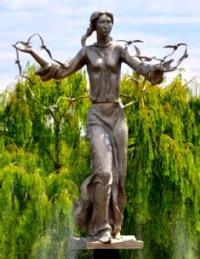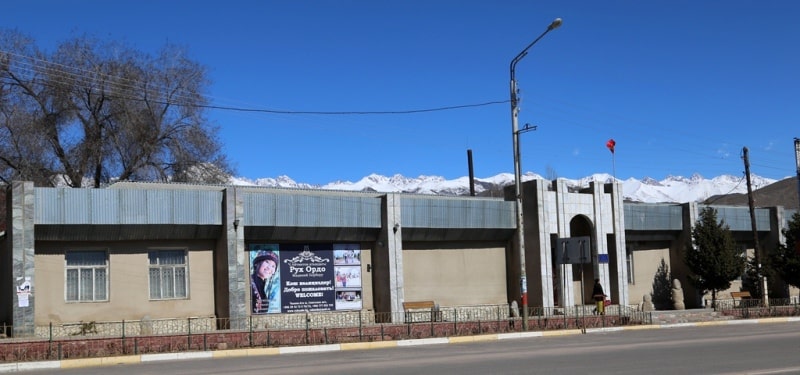Вы здесь
Cholpon-Ata town.

Trip to Cholpon-Ata.
“Cities were always like people, showing their varying personalities to the traveler. Depending on the city and on the traveler, there might begin a mutual love, or dislike, friendship, or enmity. Where one city will rise a certain individual to glory, it will destroy another who is not suited to its personality. Only through travel can we know where we belong or not, where we are loved and where we are rejected”
Roman Payne.
Excursions in Cholpon-Ata.
Cholpon Ata is the largest town (village) on the northern shore of the lake, about half way along, some 250km from Bishkek. Summer always saw large numbers of tourists descend with their vouchers for a stay in one of the nearby sanatoria or tour resorts.
Although there are still large numbers of summer visitors, the region has lost some of its appeal as it has failed to keep pace with the competition. There is a small market for everyday necessities, a yacht club, (it is possible to take boat trips on the lake), a hippodrome and a major stud farm.
A museum displays archeological finds from around the region and the Chui valley, musical instruments, traditional craftwork, exhibitions devoted to the Manas Epic and Chinghiz Aitmatov. The town also hosts a museum and library dedicated to the Kazakh writer Auezov.
The war memorial dedicated to the 214 whofell during the Second World War bears the inscription "No-one is forgotten. Nothing is forgotten". There is also a statue of Chalpon, (outside the Chalpon Cinema), and one of Lenin, and the grave of Olya of Chalpon Ata, a renowned healer and astrologer.
In the canyon above the town are forests, the Kyzyl Beirel waterfall and the Chon Koi canyon Suu. A little offshore is the sunken village of Chengu, 'red valley' the capital of the ancient Usun State in the second century B.C. and as the waters of the lake recede it is thought that the village will soon emerge from the depths.
Referred to by early Russian explorers to the region, diving expeditions were undertaken in 1956. The divers found several baked bricks, fragments of ceramic dishes, a piece of a ceramic pipe (which suggests a high level of local civilization), bronze arrowheads, iron knives, and the bones of both people and animals.
Offshore, opposite the villages of Korumdy and Temirovka and near the Grigoryevskaya harbor, archeologists found fragments of ancient pots dating back to the Bronze Age. Unfortunately, only a few of such articles are preserved because most of them were taken by local residents and tourists as souvenirs.
The knife handles are topped with large figures of horses or sheep. The horses look very realistic: with the large heads, long tails, and well-developed leg muscles typical of steppe horses.
One of the most interesting finds from the bottom of Issyk-Kul is a sacrificial table of almost square shape. It has four legs shaped like a woman's body, 22cm high. These figures are well preserved: slant eyes, wide nose, oval chin, and a short and strong neck and scholars believe they reveal the physiognomy of the ancient residents of the Issyk-Kul region. Another find was a large hemispheric sacrificial pot with two horizontal handles and a relief tamga (the seal of the master) resembling a crescent with the points directed downwards. Such pots were widespread in this region in the second half of the first millennium and more than ten such pots have been found at Issyk-Kul, this being the largest.
It is thought that such pots were used only on holidays and special occasions. The large size of these pots testifies to big feasts of ancient cattle breeders in honor of their gods. There is an open air museum, sometimes referred as a Stone Garden, which covers some 42 hectares and contains a number of prehistoric monumental structures (stone circles, tombs, the remains of a boundary stone wall, balbal) and petroglyphs (dating from the second millennium ВС up to the Middle Ages around the VIth century AD).
The stones have plaques giving some information (a short description and a date), and there are several routes marked with arrows around the Stone Garden. The shortest route in the Stone Garden takes 20-30 minutes.
But there is a longer route to the upper side of the museum, which enables visitors to explore a collection of stone balbal, stone inscriptions, stone circles and ... a spectacular panorama of the Cholpon-Ata bay of Lake Issyk-Kul.
It is often said that the best time for visit is early morning or late evening, when all the drawings are clearly seen and one can feel the atmosphere of ancient times, the times of worshippers. It is thought that the site was once a gigantic open-air temple, where ancient people worshipped heavenly bodies, in particular the sun, and perhaps other gods. The stones vary in size from about 30 cm to 3 m.
Many of the drawings are examples of the Saka-Skythian animal style of art. There are figures of hunters and what appear to be tame snow leopards during a hunt. One appears to depict hunting leopards in motion and is the only one of its kind in Central Asia.
Most of the stones face southwest and southeast and it is thought that they are connected to sun worship. It is thought that one of the purposes behind the stone circles was to serve as astronomical instruments.
The sun (solar) sign, often accompanied by chariots, is drawn on rocks along with images of animals and people, (such as hunters). There are images of deer (interestingly the image of the doe seems to have been wide-spread in the Altai, Semirechye and southern Siberia).
One of the biggest Kyrgyz tribes who worshipped the doe was called Bugu, although the Kyrgyz may themselves have migrated to the region long after these rock paintings were executed.
The art of stone inscriptions gradually disappeared with the spread of Islam to Central Asia, which restricted images of animals and human beings. However many of the forms used in these petroglyphs are still with us; they form the basis of patterns, showing different parts of animals (horns, wings, claws) are used in shyrdak (Kyrgyz felt carpets) and other forms of traditional arts and crafts.
There are other collections of petroglyphs located in the foothills of the Kungei Ala-Too mountain range, which stretches along the entire northern length of the lake, between Kyrgyzstan and Kazakhstan but the Stone Garden represents the most easily accessible and well-preserved site.
Glaciers and streams deposited some of the biggest stones here thousands of years ago. The petroglyphs were carved (using metal and stone implements) and painted and have been burnt black and brown in the sunlight during intervening years.
Recent attempts to preserve the drawings have, unfortunately, been surrounded in controversy as, it is claimed, some of the chemicals used may actually damage these historical artifacts.





Authority:
http://www.discovery-central-asia.com/archive/2006/spr14.php
Photos by
Alexander Petrov







